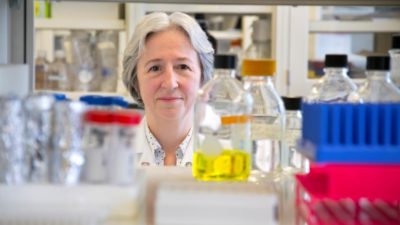Product could lead to better health care, local economic development
Researchers at the University of Missouri-Kansas City are working on a 21st century bone cement for joint replacements and other surgeries — representing a potential billion-dollar entrepreneurial opportunity.
“It could be the university’s Gatorade,” said UMKC’s Lynda Bonewald, one of the world’s leading bone scientists.
Gatorade? The popular sports drink was invented by University of Florida researchers who named the sports drink in honor of the Gators, the school’s football team. Since 1973, it’s estimated that the Gatorade Trust has earned more than $150 million in royalties for the University of Florida, allowing it to invest in dozens of health research programs.
In an effort to make bone cement “UMKC’s Gatorade,” Bonewald is collaborating with Kathleen Kilway, Chair of the UMKC Department of Chemistry; Lianxiang Bi, research associate professor in the Department of Oral and Craniofacial Sciences at the UMKC School of Dentistry; J. David Eick, adjunct UMKC professor of biomaterials; and Thomas Schuman, associate professor of chemistry at the Missouri University of Science and Technology in Rolla.
“Each year, more than a million Americans undergo joint replacement surgeries such as hip replacements or knee replacements,” said Bonewald, Director of the UMKC Center of Excellence in Dental and Musculoskeletal Tissues and UMKC Chancellor for Translational and Clinical Research. “As the baby boom generation ages, that figure will increase substantially. Those surgeries require the use of bone cement to attach the artificial joint replacement to the surrounding bone.”
The current cement commonly used for those procedures has been used for more than 40 years, said Mark Bernhardt, M.D., Chair of the Department of Orthopaedic Surgery at the UMKC School of Medicine. But the compound generates heat, damaging cells around the surrounding bone and limiting the antibiotics that can be used in the cement when needed.
“The goal is to create a new bone cement that leads to better results,” Bernhardt said. “A new bone cement also will allow for more antibiotics to be used in the cement to eradicate infection with fewer subsequent surgeries.”
In a demonstration of the new bone cement, Rachel Weiler, a UMKC chemistry graduate student, mixed a sample in a UMKC School of Dentistry lab. She demonstrated the putty-like consistency of the material, which is similar to dental composite.
“It’s glue, potentially billion-dollar glue,” Weiler said. Within 15 minutes, a marble-sized sample of the new bone cement solidified to a nearly rock-hard state.

